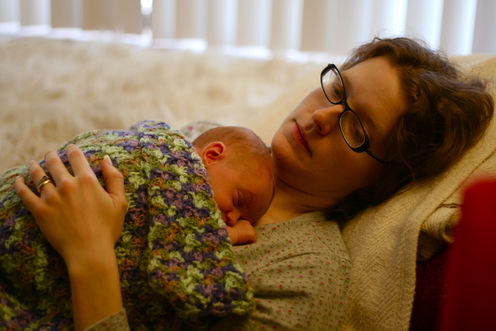
There has always been a group of people who reject vaccination. They were seen 200 years ago when Edward Jenner developed the smallpox vaccine and they persist today.
But, in recent years, commentators have lamented the apparent growth of this phenomenon. Australians have been warned about a sixfold rise in vaccine objection rates.
This has been used to justify policies such as the federal government’s No Jab No Pay. Vaccine objectors can no longer seek exemptions allowing them to receive family assistance payments if their children aren’t fully vaccinated.
Parents are sensitive to what they hear about vaccines: from doctors and other health professionals, their families and communities, in the news and online. And the rejection of vaccines can have serious consequences.
However, new data published today in the Medical Journal of Australia challenge some of the assumptions about vaccine refusal. We and our colleagues found that overall rates of vaccine objection have remained largely unchanged since 2001.
We also found that while vaccine objection is a significant problem, it’s not the only barrier to our kids being protected against diseases such as measles, polio and diphtheria.
Rates of objection
Among the broader community, vaccination coverage of young children remained relatively high and stable in the period we studied, 2002 to 2013, at over 90%.
Registered vaccine objection affecting children aged one to six years increased from 1.1% in 2002 to 2.0% in 2013. But our study findings suggest that rates of unrecorded vaccination objection have declined proportionately over this period.
This may be because more parents have become aware that registration of objection preserved eligibility for family assistance payments, which rose in value over this period.
Combining the registered and unregistered objection figures, the overall rate in 2013 stands at around 3.3% of children in Australia aged one to six years. This figure is close to that found in the last national survey of parents of incompletely vaccinated children, conducted in 2001.
Registered objectors tend to be clustered more in regional than metropolitan areas. New South Wales’ Richmond Valley had a registered objection rate of 10.8%, while in the Sunshine Coast hinterland 8.5% had a registered objection.
Many people assume that vaccine objectors refuse all vaccines for their children. But nearly half (0.9%) of the 2% with registered objection in our study had at least one vaccine recorded, either before or after vaccine objection was recorded.
So people change their minds: some parents vaccinate their child then register objection; others object then later vaccinate their child. Some always plan to have some vaccines but leave out others.
Other barriers to vaccination
Vaccine objectors aren’t the only ones who forgo vaccination. Another important but often ignored group is those who want to vaccinate their children but face other barriers. This might be due to problems with access to health services, logistical difficulties, other priorities and missed opportunities.
There’s also a group with incomplete records who are actually fully vaccinated. This can be due to errors when records are transmitted to the Australian Childhood Immunisation Register, or when they aren’t placed on the register in the first place.
Interestingly, the largest group of children noted in our study with no vaccines recorded at all were those born overseas, who we think have just not had their vaccinations recorded in our register.
These children need to have all their previous vaccines recorded, so that vaccination coverage data is more accurate, catch-up plans, where relevant, are clear, and so they can receive family assistance payments.
Vaccinating children in these groups requires adequate support at government, primary care and community level and that all catch-up vaccines are free.
Carrot and stick policy responses
The No Jab No Pay legislation amendment of 2016 removed the vaccine exemption that had previously enabled parents, if they objected, to still claim family assistance payments.
But it also expanded the existing penalty when the child turned one, two and five, to a yearly one until the child turns 19. This makes it harder for families – objectors or otherwise – to ignore the much larger financial burden.
For a low-income single-parent household in full-time work, this could be in excess of A$15,000 per year.
Some commentators have expressed concern at the punitive nature of No Jab No Pay – the stick approach.
But this questionable main course came with some good side dishes. Its promised savings enabled the health department to bring in other measures – the carrots – which would help those other groups get up to date. These included:
- incentives for GPs to get overdue children caught up
- free catch-up vaccines for older children
- communications that involve a more supportive approach to parents making decisions when they feel hesitant about vaccination.
The best part was the announcement of an expansion of the register to cover the whole of life, so all Australians can more accurately keep track of their vaccinations – due and overdue.
The burning question now is whether No Jab No Pay will have an impact on vaccination rates. The latest vaccination coverage data will be in soon. But for vaccine refusal rates, unfortunately, we no longer have the capacity to measure registered vaccine objection because it has been abolished as an exemption. This is why a full evaluation of the policy is important.
In the longer term, ongoing research of children who aren’t up to date on the register will be important to better understand why they aren’t vaccinated and direct future efforts.
But if today’s new figures provide any hints, No Jab No Pay almost certainly will have impacts. These will be due to a combination of the expanded penalty and the extras that came with it.
Julie Leask receives funding from the Australian Government Department of Health and the National Centre for Immunisation Research and Surveillance for research in addressing vaccine hesitancy. She is in receipt of an NHMRC Career Development Fellowship.
Frank Beard is employed by NCRIS.
